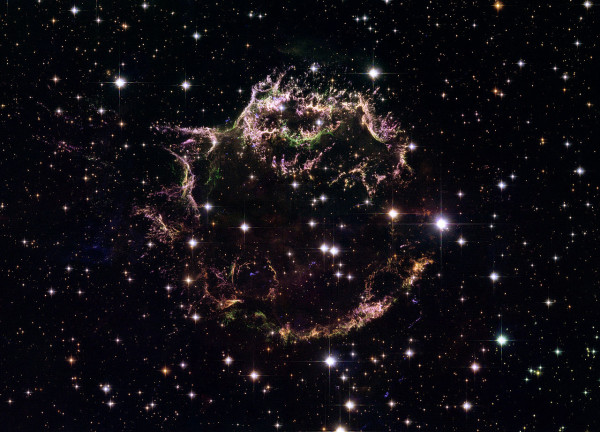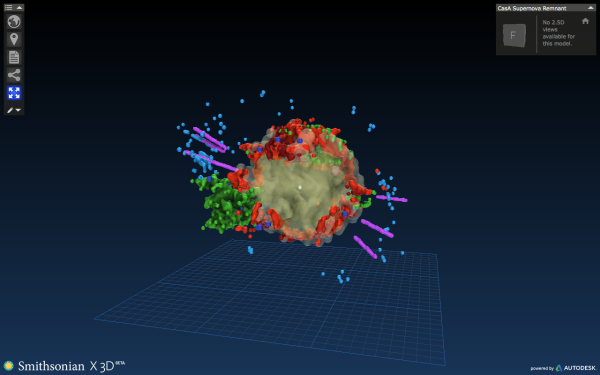“When a star goes supernova, the explosion emits enough light to overshadow an entire solar system, even a galaxy. Such explosions can set off the creation of new stars. In its own way, it was not unlike being born.” -Todd Nelsen
The vast majority of elements beyond hydrogen found on Earth were created inside a massive star and blown back into the interstellar medium in a catastrophic supernova explosion. In a certain way, everything you've ever held in your hand -- including another person's hand -- is you holding a dead star.
 The Cassiopeia A supernova remnant, as imaged in the visible part of the spectrum by the Hubble Space Telescope. Image credit: NASA, ESA, and the Hubble Heritage (STScI/AURA)-ESA/Hubble Collaboration. Acknowledgement: Robert A. Fesen (Dartmouth College, USA) and James Long (ESA/Hubble).
The Cassiopeia A supernova remnant, as imaged in the visible part of the spectrum by the Hubble Space Telescope. Image credit: NASA, ESA, and the Hubble Heritage (STScI/AURA)-ESA/Hubble Collaboration. Acknowledgement: Robert A. Fesen (Dartmouth College, USA) and James Long (ESA/Hubble).
But thanks to the Chandra X-ray Observatory and more than 13 years of observations of an expanding, young supernova remnant, we're able to construct a true 3D model of one of the galaxy's youngest dead stars. Thanks to 3D printing, you can now literally hold a dead star in your hand.
 The Cassiopeia A supernova remnant, rendered for 3D printing. Image credit: NASA/CXC/SAO & Smithsonian Institution, with a screenshot taken via http://3d.si.edu/explorer?modelid=45.
The Cassiopeia A supernova remnant, rendered for 3D printing. Image credit: NASA/CXC/SAO & Smithsonian Institution, with a screenshot taken via http://3d.si.edu/explorer?modelid=45.
New Starts With A Bang contributor Kim Kowal Arcand has the story over on Forbes!
- Log in to post comments

“The vast majority of elements beyond hydrogen found on Earth were created inside a massive star and blown back into the interstellar medium in a catastrophic supernova explosion.”
More “homogeneity” in action!
…..
Some questions for Kim Kowal Arcand on her Forbes article:
“One such supernova remnant that Chandra studies is Cassiopeia A. About 400 years ago, in our own Milky Way galaxy, a star that was about 15 to 20 times the mass of our Sun, detonated in a supernova explosion.”
How long will the remnants of Cassiopeia A be detectable? Anywhere close to the way the CMB is said to be detectable after 13.8 billion years?
“Because Cassiopeia A is the result of an explosion, the stellar debris is expanding radially outwards from the explosion center. Using simple geometry and the Doppler effect, we can create a 3-D model.”
Kim, if WE are 3-dimensional and Cassiopeia A was 3-D, isn’t are universe 3-D?
Why, using simple geometry and the Doppler effect and whatever, can’t we create a 3-D model of our universe?
Because I want to know where the center of our 3-D universe is, where the Big Banged.
“It’s all about understanding our origins. You know, those three questions that are, I think, so common, that we ask ourselves: Where do we come from? What are we? Where are we going? What can be more exciting than those questions.”
I think I can answer for the atheist scientism-ists here:
“Where do we come from?”
From a Big Bang that went from a teeny point to the size of a marble to the size of what we have now.
“What are we?”
A peculiar collection of atoms no better or worse than any other collection of atoms.
What we call “life” is just a very rare and very recent "natural" anomaly in the 13.8 billion year history of what is.
“Where are we going?"
We are going to die,
and maybe have our atoms mixed in with a future cantaloupe or comet.
Very exciting, indeed.
How many times will you ignore the explanation?
http://math dot ucr dot edu/home/baez/physics/Relativity/GR/centre.html
http://spaceplace dot nasa dot gov/review/podcasts/transcripts/070523_universe.html
from
https://www dot cfa dot harvard.edu/seuforum/faq.htm
Not that anybody expects you to read any of those items, or try to understand them if you did.
But, the next time you scream "where is the center of the universe? Why won't anyone tell me? like a five year old, we have another place to point and say "You were given an explanation, you simply wouldn't look at it."
Oh, G-d, I can't help myself.
The stalwart ignorance and sin of pride are strong in S.N.
^ Almost forgot:
Is there some reason that you're not posing these at Forbes?
Thanks for the article, Kim & Ethan. Looks like a 3D project for the weekend coming up !
:)
Rather than classifying palate by energy it would have been interesting to classify by element. In theory we know where the elements reside in the pre-exploded star, so a 3D model of their current locations and velocity should allow the event modeling from pre-explosion all the way through to now.
It occurs to me that this would also be an excellent time for S.N. to detail his understanding of Doppler redshifts, which he apparently accepts, viz.,
and cosmological redshifts, which he rejects:
@Denier #6: That's a very interesting idea! I'm not sure that it would work -- my understanding from numerical simulations is that core-collapse supernovae are extremely turbulent, so the different "onion layers" get quite thoroughly mixed in the debris. Additionally, the extremely high neutron flux drives the "r-process", which produces all of the heavy elements we know and love :-)
@Michael Kelsey #8
That is the fun of science. Hold your breath and hope observations match theory or figure out why they didn't.
If the Supernova happened 400 hundred years ago then how can we see it given that it is 10000 lightyears away?
@Heistenberg #10: The star was seen to explode on Earth 300-400 years ago.
" Because I want to know "
No, you don't want to know, you want to believe your fairy story is true.
That;'s what you WANT. All your JAQing off is merely to pretend in public that you're genuine, when it's apparent to every sentient being you aren't in the least.
further to #11, that means the star blew up 10,400-ish years ago. It took 10,000-ish years for the light to travel and got here 400-ish years ago.
And here, 0 years ago, we're talking about it.